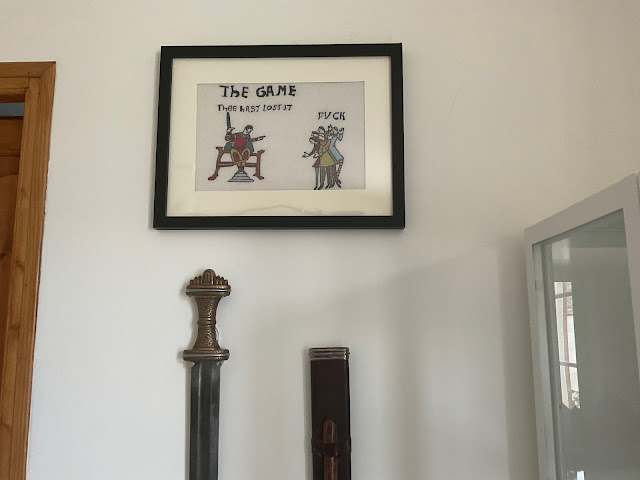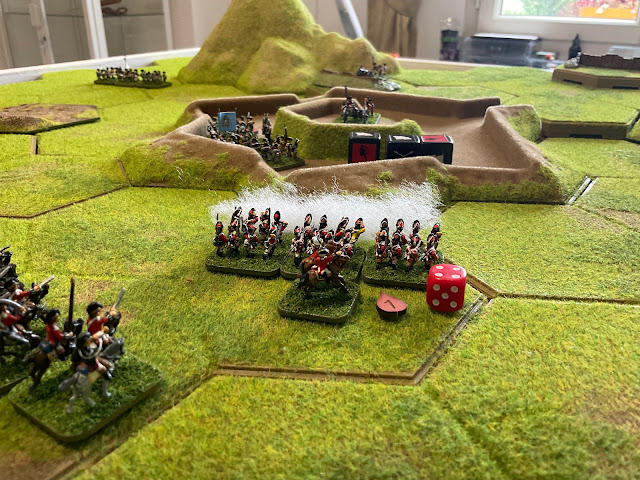 |
| Huzzah for General Cummings and Parrott. Stout fellows! |
The story so far.
The British under General Parrott had discovered the American guns on the cliffs at Pringle Point but a stout defence from the untrained militia had fought them to a standstill. Overnight the British pulled back to regroup, joined early on the 9th by the remnants of the dragoons and two fresh battalions of light bobs under general Sykes.
The American General Cummings had been surprised and relieved at his militias stout defence and even as the British pulled back his own reinforcements began to gather.
We take up the action sometime around turn 3. General Cummings and his continentals have arrived in the far right corner of the map, artillery following, and his fast moving riflemen outpacing the main column to take up positions at the edge of the woods.
General Parrott has retired from the previous battle at Pringles Point (top far left ish ) shadowed by two columns of Militia under General Motte. The previously mauled British dragoons swing around the hills (on the left) to join up with General Parrott. Meanwhile two battalions of light bobs finally make it to the dance under General Sykes. Supplies wise this encounter is pretty much shit or bust for the British. If they can cripple the Americans here they’ll still be able to march west and silence the now barely defended coastal artillery.
First blood goes to General Parrott whose grenadiers turn on the shadowing American militia and inflict losses with a well timed volley to cover the unlimbering artillery.
The leading British light infantry engage in melee with the American riflemen in the woods but the advancing Continentals on their flank let loose a tremendous volley that shatters their confidence despite inflicting no real losses. Nerve broken they run. In Tricorne a flag rolled on a dice means the unit must retreat. The lights have Sykes with them and can ignore one flag but the other two means they have to retire two hexes. Sykes tests for being hit but perhaps because he leads from the back he turns out to be fine.
General Parrott’s artillery unlimber and fire at the shadowing militia. Casualties are inflicted and the militia have little choice but to try moving back out of range. Seeing that the Americans are now fully occupied by his artillery General Parrott moves his grenadiers into cover of the impassible terrain, intent on securing the central area of the map in order to bottle the Americans up in the one corner.
The light bobs under Sykes réorganise themselves after their fright and in the meantime the second battalion of lights advance towards the American rifles in the woods. Without the support of a senior officer to urge them on they are forced back by a fusillade of American rifle fire. Two flags rolled mean a retreat of two hexes and a morale check…
Which they fail! They needed to roll just 1 flag to pass and there are two flag symbols on each dice.
The battalion breaks and the demoralised men run from the battlefield. Oh the shame of it.
The American militia take more and more casualties from the British guns until they manage to retire out of range. This retirement unmasks the American artillery who begin a counter bombardment. After several turns the British gunners run, abandoning their damaged cannons. Fortunately the British dragoons finally show up. Should they charge the weak militia and brave the blizzard of fire before they can get to them or head off to support the grenadiers in the centre? Still nursing 2 out of 4 hits from the previous battle they choose the latter.
After reorganising, the remaining lights under Sykes begin a desultory long distance fire on the continentals but the results are poor and it becomes clear that must get in close to inflict any serious losses. Fortunately General Parrott with his grenadiers and dragoons come to the same conclusion and draw some of the American fire as they all advance into the centre at the same time.
The dragoons charge ahead of the grenadiers but take the brunt of the American firepower. They too break and run (or should that be gallop ?) from the field.
Finally generals Parrott and Sykes arrive at the enemy positions. But it’s General Cummings and General Parrott who face off as the continentals and the grenadiers go hand to hand.
Disaster. The grenadiers pile in - their blood up and the continentals are routed with heavy casualties. Somehow surviving the assault General Cummings takes shelter amongst the nearby riflemen.
General Parrot’s men turn to strike the riflemen in the tree line as a bonus attack but fail to dislodge them. The American militia rush to plug the gap in the pass left by the continentals.
Général Sykes men put the riflemen to the sword, chasing them through the woods. As they flee a final volley cuts more of them down and makes the survivors scatter.
Still mounted General Cummings tries to halt his fleeing men by waving his sword around in an encouraging manner but he too is cut down in the hail of fire. Shot in the back by the dastardly British!
Two crossed sabres in ranged fire = K I A. In melee only 1 is required.
Alas poor Cummings I knew him well. Sort of.
Perhaps annoyed at Sykes’ success the grenadiers turned on the militia plugging the gap in the terrain and made short work of them. General Motte fled back to his second militia battalion.
The breaking militia unmasked the American artillery who swiftly loaded canister and readied for hand to hand combat. As the British grenadiers raced towards the gunners General Parrott riding bravely at their head the cannon let loose with a mighty roar.
General Parrott had written to his wife the day before the battle expressing his intent to be posted back to Sir Henry Clinton’s staff…and in this matter at least he got his wish.
Shame he had to be posted back in several different parcels. Lol.
Both sides had reached exhaustion. Sykes, knowing that his remaining troops were badly needed back at Coldstream and aware that American Provincials were somewhere to his rear (on the strategic map) called off the assault, while General Motte led the mauled remnants of his force back to the safety of the fortifications and the coastal cannon.
The loss of both Generals and the poor state of the remaining forces led this campaign i thought to a natural conclusion, though the matter of the greater strategic issue still needed to be resolved.
There were twelve ships in the British supply convoy and I intended that the coastal artillery would get a crack at them as they sailed past. I felt a 1D6 roll against each ship with a 6 reflecting its destruction would suffice for want of anything better.
So I rolled this bucketful (apologies for the very dark image).
And found that not a single ship was sunk!
So where does that leave things?
General Cummings succeeded in his brief to protect the coastal artillery - albeit at the cost of his life, and General Parrott’s loss was also not in vain since the convoy got through and Sir Henry Clinton’s offensive could take place as planned.
Both of my generals were great sports and kept an old man thoroughly entertained as they struggled with the vagaries of fate.
Mistakes were made and sometimes the generals made strange choices but it’s easy to criticise when you are aware of the complete picture…and they’re not.
Observations.
The use of a hexed map for the players to move their units over was a poor decision. It was overly complex and a point to point one would have been far better. Lesson learned.
Each player was given 28 points pre game with which to purchase supplies, units, intelligence, seaborne landings etc. General Parrott spent heavily on high quality units, full intelligence and a seaborne landing but only 4 of his 28 points on supplies. Given that each turn his forces would use 1 point of supplies just marching in the field and 1 if any battle occurred this was a major error. Fortunately for the British a lucky random event provided a few supplies from HQ which kept him going just long enough to get within striking distance of his objective. Just. The British had 1 unit of supplies left on the day of the final battle. This might help explain the mad mid game panic of promissory notes and his attempted slave rebellion. Lol. Displaying perhaps a little too much caution General Parrott had two good quality line units that never moved the whole game and whose only activity was to build defences in place. I suspect their presence would have swung the battle of Pringle Point in his favour.
Ah well could’ve would’ve should’ve and all that.
General Cummings probably had less of a difficult job overall, but his reliance on cheap militia units nearly cost him dear. In his total command only the 1 unit of continentals and a battalion of rifles could be considered reliable. The good General spent heavily on supplies and expended lots of them building the large earthen fort that protected the militia and the guns at Pringle Point. Diplomatically he was very sure footed, showing steel in his dealings with the deserters and compassion with the errant farmers taking supplies to General Parrott.
Should he have diverted a battalion of militia to protect the settlers from the Cherokee raiders? Mmmm. Maybe. Maybe not. Their absence wasn’t to prove decisive so any criticism is a little harsh.
Despite the many positives I’ve listed here we have to remember that he still got shot in the back as his men ran away. So there’s that I suppose. Lol.
Overall the campaign was quite short with only three battles - but in fairness I designed it that way so that it didn’t turn into a ball ache for all concerned. Hopefully it kept the two participants and you dear reader, amused?
Toodleooh






























